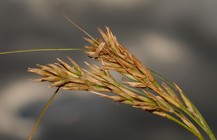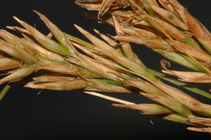Cyperaceae taxon details
Carex basutorum (Turrill) Luceño & Martín-Bravo
1678124 (urn:lsid:marinespecies.org:taxname:1678124)
accepted
Species
Schoenoxiphium basutorum Turrill · unaccepted
terrestrial
(of Schoenoxiphium basutorum Turrill) (1914). IV.-Diagnoses Africanae: LVI. <em>Bull. Misc. Inform. Kew.</em> 1914(1): 16-21., available online at https://www.biodiversitylibrary.org/page/11831552
page(s): 19 [details]
page(s): 19 [details]
Description Rhizome caespitose, with short internodes, moderately stout, brown. Flowering culms (25)30–60(65) cm long, acutely...
Taxonomic remark Source in seed data: ipni Update namepublishedIn from Bot. J. Linn. Soc. 179: 26. 2015 [14 Jul 2015] [epublished] to Bot....
Description Rhizome caespitose, with short internodes, moderately stout, brown. Flowering culms (25)30–60(65) cm long, acutely trigonous and smooth or scarcely scabrid at the apex, leafy usually up to the upper third of its length, (0.6)0.9–1.4(1.5) mm wide at the middle. Leaves (0.3)1–1.5(2.3) mm wide, shorter, equaling or longer than the inflorescence, soft to scarcely rigid, light green, carinate or canaliculate, rarely trigonous or somewhat flat in cross-section, scabrid along the edges in all its length; abaxial surface smooth, except frequently in the midrib; adaxial surface smooth; trigonous and curled at the tip; ligule 1.5–3(3.7) mm long. Basal sheaths more or less fibrous, with lamina, but the lowest bladeless. Lowest bract of the inflorescence leaf-like, longer or, more rarely, shorter than the inflorescence, not sheathing. Inflorescence branching up to 2(3) times; partial inflorescences (3)5–8(10) overlapping or, rarely, the lowest somewhat distant; sessile to shortly pedunculate, erect to suberect. Glumiform perigynia and glumiform cladoprophylls absent. Tubular cladoprophylls present in the lowest partial inflorescence, rarely absent, hyaline. Utriculiform cladoprophylls always present. Male glumes 4.2–7 × 1.5–1.9 mm, ovate to ovate-lanceolate, pale reddish-brown, with a narrow, green central band, acute, acuminate to shortly aristate. Female glumes (4.1)4.8–6.3(6.8) × 1.7–2.2(2.4) mm, ovate, pale reddish-brown, with a green central band, acute, acuminate or more frequently ending in a smooth ariste up to 1 mm. Unisexual utricles (5)6–7.2 × 0.7–1 mm, narrowly linear, shortly stipitate, straight or, very rarely, slightly arcuate, greenish, straw coloured to pale brown, densely papillose-scabriuscule at least in the upper half, with numerous prominent veins across the entire surface, erect to suberect, very gradually attenuated into an irregularly lacerate, asymmetrically truncate, bidentate or bifid beak up to 2 mm long; rachilla protruding from the apex of the utricle up to 1.5 mm. Bisexual utricles wide and obliquely truncate. Achenes (3.5)3.8–4.2 × 0.6–1 mm, oblong-trigonous, yellowish-brown, tipped by a trigonous, acute, persistent style base. [details]
Taxonomic remark Source in seed data: ipni Update namepublishedIn from Bot. J. Linn. Soc. 179: 26. 2015 [14 Jul 2015] [epublished] to Bot....
Taxonomic remark Source in seed data: ipni Update namepublishedIn from Bot. J. Linn. Soc. 179: 26. 2015 [14 Jul 2015] [epublished] to Bot. J. Linn. Soc. 179: 26 (2015), information provided by Alan E. on email Jun. 07 2021 [details]
Cyperaceae Working Group. (2025). [see How to cite]. Global Cyperaceae Database. Carex basutorum (Turrill) Luceño & Martín-Bravo. Accessed at: https://cyperaceae.org/aphia.php?p=taxdetails&id=1678124 on 2025-09-11
Date
action
by
2024-12-10 11:47:54Z
unchecked
db_admin
![]() The webpage text is licensed under a Creative Commons
Attribution 4.0 License
The webpage text is licensed under a Creative Commons
Attribution 4.0 License
Nomenclature
original description
(of Schoenoxiphium basutorum Turrill) (1914). IV.-Diagnoses Africanae: LVI. <em>Bull. Misc. Inform. Kew.</em> 1914(1): 16-21., available online at https://www.biodiversitylibrary.org/page/11831552
page(s): 19 [details]
replacement name source Global Carex Group. (2015). Making <i>Carex</i> monophyletic (Cyperaceae, tribe Cariceae): a new broader circumscription. <em>Botanical Journal of the Linnean Society.</em> 179(1): 1-42.
page(s): 26 [details] Available for editors [request]
[request]
basis of record Plants of the World Online (POWO). , available online at https://powo.science.kew.org/ [details]
page(s): 19 [details]
replacement name source Global Carex Group. (2015). Making <i>Carex</i> monophyletic (Cyperaceae, tribe Cariceae): a new broader circumscription. <em>Botanical Journal of the Linnean Society.</em> 179(1): 1-42.
page(s): 26 [details] Available for editors
basis of record Plants of the World Online (POWO). , available online at https://powo.science.kew.org/ [details]
Taxonomy
redescription
Luceño, M.; Villaverde, T.; Márquez-Corro, J. I.; Sánchez-Villegas, R.; Maguilla, E.; Escudero, M.; Jiménez-Mejías, P.; Sánchez-Villegas, M.; Miguez, M.; Benítez-Benítez, C.; Muasya, A. M.; Martín-Bravo, S. (2021). An integrative monograph of <i>Carex</i> section <i>Schoenoxiphium</i> (Cyperaceae). <em>PeerJ.</em> 9: e11336., available online at https://doi.org/10.7717/peerj.11336 [details] Available for editors  [request]
[request]
Other
additional source
Govaerts, R.; Nic Lughadha, E.; Black, N.; Turner, R.; Paton, A. (2021). The World Checklist of Vascular Plants, a continuously updated resource for exploring global plant diversity. <em>Scientific Data.</em> 8: 215., available online at https://doi.org/10.1038/s41597-021-00997-6 [details]
 Present
Present  Inaccurate
Inaccurate  Introduced: alien
Introduced: alien  Containing type locality
Containing type locality
From editor or global species database
Description Rhizome caespitose, with short internodes, moderately stout, brown. Flowering culms (25)30–60(65) cm long, acutely trigonous and smooth or scarcely scabrid at the apex, leafy usually up to the upper third of its length, (0.6)0.9–1.4(1.5) mm wide at the middle. Leaves (0.3)1–1.5(2.3) mm wide, shorter, equaling or longer than the inflorescence, soft to scarcely rigid, light green, carinate or canaliculate, rarely trigonous or somewhat flat in cross-section, scabrid along the edges in all its length; abaxial surface smooth, except frequently in the midrib; adaxial surface smooth; trigonous and curled at the tip; ligule 1.5–3(3.7) mm long. Basal sheaths more or less fibrous, with lamina, but the lowest bladeless. Lowest bract of the inflorescence leaf-like, longer or, more rarely, shorter than the inflorescence, not sheathing. Inflorescence branching up to 2(3) times; partial inflorescences (3)5–8(10) overlapping or, rarely, the lowest somewhat distant; sessile to shortly pedunculate, erect to suberect. Glumiform perigynia and glumiform cladoprophylls absent. Tubular cladoprophylls present in the lowest partial inflorescence, rarely absent, hyaline. Utriculiform cladoprophylls always present. Male glumes 4.2–7 × 1.5–1.9 mm, ovate to ovate-lanceolate, pale reddish-brown, with a narrow, green central band, acute, acuminate to shortly aristate. Female glumes (4.1)4.8–6.3(6.8) × 1.7–2.2(2.4) mm, ovate, pale reddish-brown, with a green central band, acute, acuminate or more frequently ending in a smooth ariste up to 1 mm. Unisexual utricles (5)6–7.2 × 0.7–1 mm, narrowly linear, shortly stipitate, straight or, very rarely, slightly arcuate, greenish, straw coloured to pale brown, densely papillose-scabriuscule at least in the upper half, with numerous prominent veins across the entire surface, erect to suberect, very gradually attenuated into an irregularly lacerate, asymmetrically truncate, bidentate or bifid beak up to 2 mm long; rachilla protruding from the apex of the utricle up to 1.5 mm. Bisexual utricles wide and obliquely truncate. Achenes (3.5)3.8–4.2 × 0.6–1 mm, oblong-trigonous, yellowish-brown, tipped by a trigonous, acute, persistent style base. [details]Taxonomic remark Source in seed data: ipni Update namepublishedIn from Bot. J. Linn. Soc. 179: 26. 2015 [14 Jul 2015] [epublished] to Bot. J. Linn. Soc. 179: 26 (2015), information provided by Alan E. on email Jun. 07 2021 [details]
To European Nucleotide Archive, ENA (Carex basutorum)
To GenBank (4 nucleotides; 1 proteins)
To GenBank (4 nucleotides; 1 proteins) (from synonym Schoenoxiphium basutorum Turrill)
To International Plant Names Index (IPNI) (from synonym Schoenoxiphium basutorum Turrill)
To International Plant Names Index (IPNI)
To Plants of the World Online
To Plants of the World Online (from synonym Schoenoxiphium basutorum Turrill)
To Royal Botanic Gardens, Kew (Schoenoxiphium basutorum K000363525 type 1) (from synonym Schoenoxiphium basutorum Turrill)
To GenBank (4 nucleotides; 1 proteins)
To GenBank (4 nucleotides; 1 proteins) (from synonym Schoenoxiphium basutorum Turrill)
To International Plant Names Index (IPNI) (from synonym Schoenoxiphium basutorum Turrill)
To International Plant Names Index (IPNI)
To Plants of the World Online
To Plants of the World Online (from synonym Schoenoxiphium basutorum Turrill)
To Royal Botanic Gardens, Kew (Schoenoxiphium basutorum K000363525 type 1) (from synonym Schoenoxiphium basutorum Turrill)
From editor or global species database










